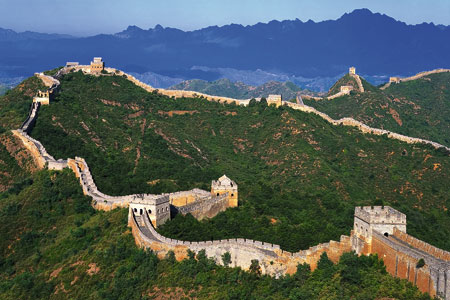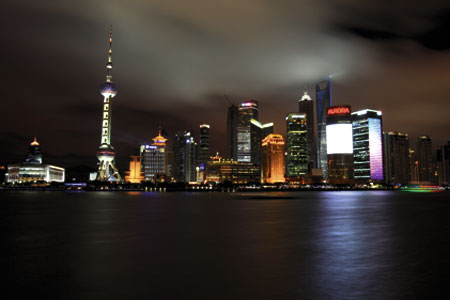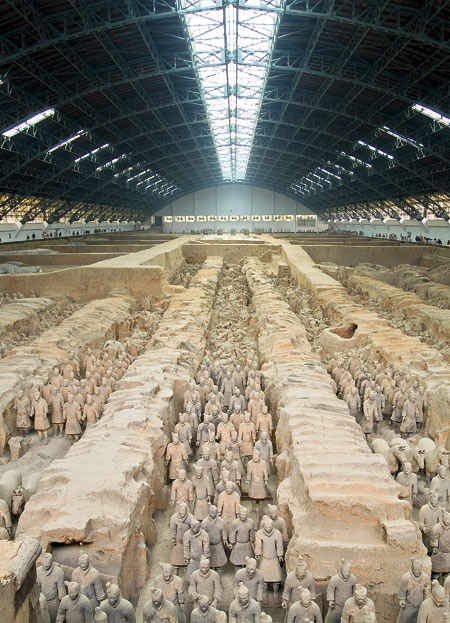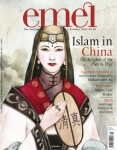
The Land of Wonders
Issue 73 October 2010
The land of the orient, the Middle Kingdom, a land of wonders; and today, one of the world’s new superpowers, fusing past and future in the most innovative of ways. As the Chinese saying goes, “If you want to see 2,000 years of China, go to Xian. 500 years, go to Beijing. 200 years, go to Shanghai.” Ethar El-Katatney explores China.
Shanghai

Described as a cross between New York and Times Square, Shanghai is a very new city. The second largest city in China in terms of population (over 20 million), it is without doubt the most Western looking: over 1,000 buildings are over 30 stories high and 4,000 are over 16 stories high.
The bund (waterfront) at night is a sight to behold. The city is all decked out in lights, and towering skyscrapers transform into giant television screens. If you have the time, a cruise on the river will leave you elated.
And not for the fainthearted, 432 metres and 101 floors above the ground at the Shanghai World Financial District skyscraper, you can walk across a glass floor, surveying Shanghai from above.
A day trip to one of the nearby water cities is also an interesting experience. In Suzhou, referred to as the Venice of the East, you can ride a gondola through the city, and visit a silk mill to see the silk-making process - initiated by touching the worms, as Shanghai is the centre of silk production in China.
Shanghai’s gardens are beautiful, with the Yuyuan Gardens being the most famous. They are located in a market that is a tourist’s dream come true - architecture and Dairy Queen simultaneously. If you’re into shopping, Shanghai is the place to go, and the famous pedestrian-only Nanjing Road is the place to be. If you prefer art galleries, the centre of Shanghai’s buzzing art scene is at Moganshan Road, a collection of once-deserted warehouses.
The Jade Buddha temple is famous for two main Buddhas - the jade Buddha and the reclining Buddha. Carved out of one piece of jade, the jade Buddha weighs two tonnes, and is surrounded by dozens and dozens of pure gold tiny Buddhas. The temple also hosts one of the largest koi ponds in China, brilliant fish in shades of orange and yellow which can live to well over 200 years old.
If you’re planning a trip to China in the next couple of weeks, make sure you drop by the World Expo, a brilliant celebration of the world’s cultures which ends on 31st October. A word of warning, however: queues are known to exceed three hours! To get back to the airport, at speeds of up to 430km/h, take the meg-lav train, of course.
Xian

Two thousand years ago Xian was the capital of China, and the start of the famous Silk Road. Today, it is most famous for the Terra Cotta Warriors, discovered only thirty years ago (the farmer who discovered them can be found signing autographs at the souvenir shop).
Eight thousand clay soldiers were built to defend the grave of Qin Shihuang, the first emperor of unified China. Incredibly, no two faces of the life-size warriors are the same: each and every one is unique, down to their hair partings. Since they were painted, the archers and soldiers have long lost their colour. An incredible sight, this is one wonder you wouldn’t want to miss.
Likewise, the Grand Mosque of Xian, over 1,000 years old, is a must visit: stunning Chinese architecture, beautiful gardens, and a pervasive sense of serenity. Directly outside the mosque is the Muslim quarter, which is a Muslim Chinese version of London’s Portobello market. Here, you can buy exotic foods, spices, and herbs and all the souvenirs you like - but make sure to haggle. And if you have a free evening, attend a Tyng Dynasty show.
Beijing

Most likely, the Great Wall of China, built in 220 BC, will be your first stop in Beijing. A wonder of the ancient world, construction continued until 1644, making the Great Wall the world’s largest military structure, with significant historic and strategic importance. For the able-bodied enthusiast, you can make it all the way to the top. Just don’t get discouraged by the 80 year old Chinese men, eight year old children and women in high heels jogging up the very steep staircase.
Next up is Tiananmen Square, the largest city square in the world, adorned with Chairman Mao’s portrait and best remembered for the image of the lone bystander standing defiantly in front of a tank. Literally meaning ‘heavenly peace’, Tiananmen Square leads to the Forbidden City, which was the imperial palace for over five centuries. Touch the golden knobs at the gate for luck, and make your way to as many of the 980 buildings as you can. Statuettes on top of a building represent its rank, with 10 representing the highest rank.
The Summer Palace, built by China’s infamous dragon lady, is worth a stop, being the world’s largest garden - with hills, an artificial river, pavilions, bridges and a beautiful shaded corridor painted with hundreds of unique designs.
For those into shopping, the Wangfujing pedestrian street is a mix between high street stores like Zara and high-end stores like Hermes. More interesting is a side street into the Donghuamen night market, set up in 1924 and which sells over 100 kinds of food, including scorpions, beetles, cockroaches, eels, lizards.
Your visit to Beijing wouldn’t be complete without a hutong tour - a ride on a rickshaw into old Beijing’s alleyways. If you go early, you might also catch the daily morning drum ritual, which used to be heard throughout China every hour to let citizens know the time. The Lama Buddhist temple is also worth a visit, as are the panda gardens.
Don’t leave Beijing without getting a foot massage, for which the city is famous. Attend a tea ceremony, and make sure to ask for your ‘pee pee’ boy souvenir. The Chinese acrobatic show and the Kung Fu show are both jaw-droppingly spectacular, and if you enjoy the opera, the Chinese opera boasts spectacular costumes and makeup.
Travel Tips
- Make sure to carry a hotel card with you - most have the main tourist attractions printed on them in Chinese, which can be very helpful when you are taking a taxi, since most taxi drivers do not speak English.
- Always haggle. Whatever price you are given, start negotiating at 10% of that price since Chinese sellers are notorious for seriously upmarking their prices.
- Jade, pearl and silk are great Chinese buys, but make sure to buy them from sellers authenticated by the government.
- Xie xie (thank you, pronounced Che-Che) will go a long way. Most Chinese do not speak English, and your courtesy is very much appreciated.
Bookmark this |
|
Add to DIGG |
|
Add to del.icio.us |
|
Stumble this |
|
Share on Facebook |
|
Share this |
|
Send to a Friend |
|
Link to this |
|
Printer Friendly |
|
Print in plain text |
|


Comments
0 Comments